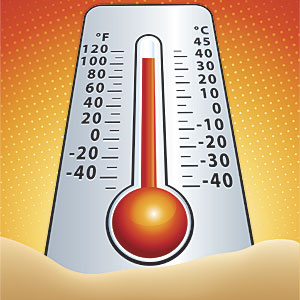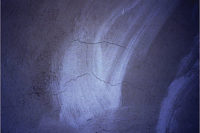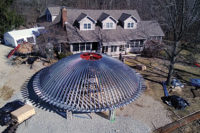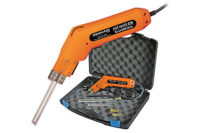I was born in it, as a child played in it and managed to make a living in it. As kids we weren’t afraid of it—but then, we really didn’t know any better. Most people hide from it and can’t understand how we even tolerate it. In Arizona, it is referred to as dry, the preferred form, but really isn’t very preferable at all. I’m talking about heat, specifically the intense version us plasterers in Arizona deal with four to five months out of every year. I have learned a thing or two about spreading mud when it’s hot and would like to share some of my “hot” tips.
Start Early
We got to work before it was light and had mud to the end of the hose, or in the mixer when we were hand jiving, by the time it was light enough to see what we were doing. In the middle of summer we were usually spreading about 4:30 a.m. or so, breaking for lunch at 9:00 a.m. and getting off around noon. When it got to be crunch time, we would work at night too.
During the dog days of summer, it was common to run two shifts, sort of a swing shift version, with the hottest part of the day as the “off time.”
Understand Global Orientation
When the sun rises, you still have some time to work directly in it. Start on the south side of the building, and the roof first thing in the morning. You can usually work these areas for about three to four hours or so before the brains begin to cook. Next, move to the west side, then the east side and finally the north side. When we had to work past noon, we always worked on the east and north sides only. Remember that on the east side, the sun has had a few hours to bake it, and it will retain some of the heat even though the sun isn’t shining directly on it. This residual heat, surface heat, can dry the wet mud products very quickly on the underside of the surface which could compromise initial adhesion to the substrate.
Shading
This is the simplest way to keep a wall/working surface cool. The most cost efficient product is black plastic (6 mil). It can be pinned to the backside of the scaffold where the crews are spreading mud. Yes it is hot but only directly next to the plastic. It completely blocks UV rays and gives solid shade. At the working areas of the scaffold, it is surprisingly cool(er). Caution should be used in windy conditions because the plastic acts like a sail.
Lightweight tarps are really good and many are manufactured with company logos, decorative patterns or differing colors. They are breathable and durable for reusing on multiple jobs. They do allow for some passing of UV rays but do a good job of keeping the working areas cool. (If there is a slight breeze, you can wet the tarps and enjoy a large evaporative cooler effect.)
Note: Don’t wrap the shading materials over the top of the scaffold and onto the roof. You’ll just make an oven and your guys will cook. This process is reserved for the winter months when you wrap and heat.
Keep Your Materials (And Your Hoddy) Cool
A bag of cement will hold heat for at least 24 hours. If you leave the bag materials in the direct sun, they will get hot and stay that way. When you begin to mix hot bags, the heat within immediately starts the chemical hardening process which lessens the life of the mud, considerably. Always use cool potable water, mixing with hot water will also shorten the wet consistency of the mud.
This may require purging the hot water from the hose before tuning the stream to the mud mix (for water conservation, see wetting the empty cement bags later in this column) The sand pile can also be affected by the heat, although it doesn’t hold much residual heat within because of the moisture content. In the morning you can take sand right off the top, but save the “inside” sand for when it gets really hot. We sometimes built shade structures out of scaffolding, for the hoddy to keep him and his materials cool, sort of a Hoddy Shack. When we were pumping we would lay empty cement and lime bags over the hose near the pump area and the hoddy would keep them wet. These bags became little evaporative coolers.

When we had an EIFS job, we stored the pails inside an empty room within the building until it was time to move them to the mixing area. A trick we used was to place the pails in a kiddie pool, in the mixing area, that was filled with ice water just before mixing and sending them to the wall areas. (You will use a lot of ice.) We also built Hoddy Shacks for the guy mixing the pails. This kept the mixed materials from getting too hot and shortening the pot-life. It also kept the hoddy from getting too cranky; happy hoddy, happy plasterers. If you are using dry mix basecoat products, don’t leave them in the direct heat.
Cadillac
You’ve seen them at the malls or restaurants; they spit mist to drop the ambient temperature and are called misting systems. Here in Arizona, you can buy the misting heads at your local home building supply store. It is pretty easy to make a misting rod of a desired length. Place the misters on the backside of the scaffold, inside of the shading device and enjoy the cooling effects. I refer to this as a Cadillac because it is a bit costly. The misters need good water pressure to work efficiently, require a lot of water hose and the tips clog easily with high alkaline water sources. Plus, on multiple scaffold levels, you’ll need a set-up for each level. But man is it cool.
Clothing
It is also important to keep your bodies cool, too. Most of us wore long-sleeved shirts and T-shirts underneath. We tied a scarf over our heads to shade our necks and ears, and wore a rolled up scarf tied around our neck. This starts out a little warm but once the sweat gets the articles wet, the breezes cool off the body via evaporation. (We usually had two of everything for a quick change at lunch time to minimize lime burns.) Having your skin covered from direct exposure to the sun keeps one cooler a lot longer than you would expect. Think desert Nomads and their camel caravans, no exposed skin on them. Counter-intuitive I know but covering all exposed skin really helps. Sunglasses and gloves finish out the ensemble.
Process
We all know that stucco goes through a hydration process whereby the water within the mix causes a chemical reaction between the cement, lime and sand. After the hydration process, the water simply evaporates leaving behind a solid stucco cladding. During the hot summer months evaporation happens really fast, and in the wind, even faster. So then, during the hot times, slowing down the evaporation of the stucco cladding, or adding moisture back into the stucco cladding becomes an important factor. Allowing water to evaporate quickly does compromise the hydration process and the integrity of the stucco cladding.
For EIFS basecoats, the hydration process still occurs, although to a lesser degree because of the acrylic modification. However, it is still important that the basecoat materials not dry too quickly. On your double-back basecoat skim coat, make sure the surface is not real hot. If it is, you will not have good adhesion and the skim coat could someday flake right off. It is not readily visible during application and usually won’t rear its ugly head until later. Check with your EIFS manufacturer for specific application procedures and temperature ranges of their products.
When it comes time to do the finish, don’t try to spread it on a hot wall. You will have a lot of frustration, little working time and the finished product may look less than desirable. For stucco walls you can mist the brown coat to drop the surface temperature, the key word being “mist.” Soaking the walls can lead to blotchy finishes in both colored cement and acrylic finishes. EIFS basecoats can hold a lot of surface heat during the summer. Unlike cement you can’t really mist the base coat before applying the finish without running the risk of leaving a blotchy color. Shading and working on cool walls via “global orientation” are the two methods best used for EIFS. Priming coats made for acrylic finishes also help with workability.
We all have to work during the hot days of summer. A little pre-application preparation and next-day foresight go a long way to make working in the heat a little easier. At the end of the day, don’t just clean-up and go home, take the time to protect the work completed, your material stocks and if necessary, leave behind someone to keep the walls wet. Stay cool my friends.





Report Abusive Comment